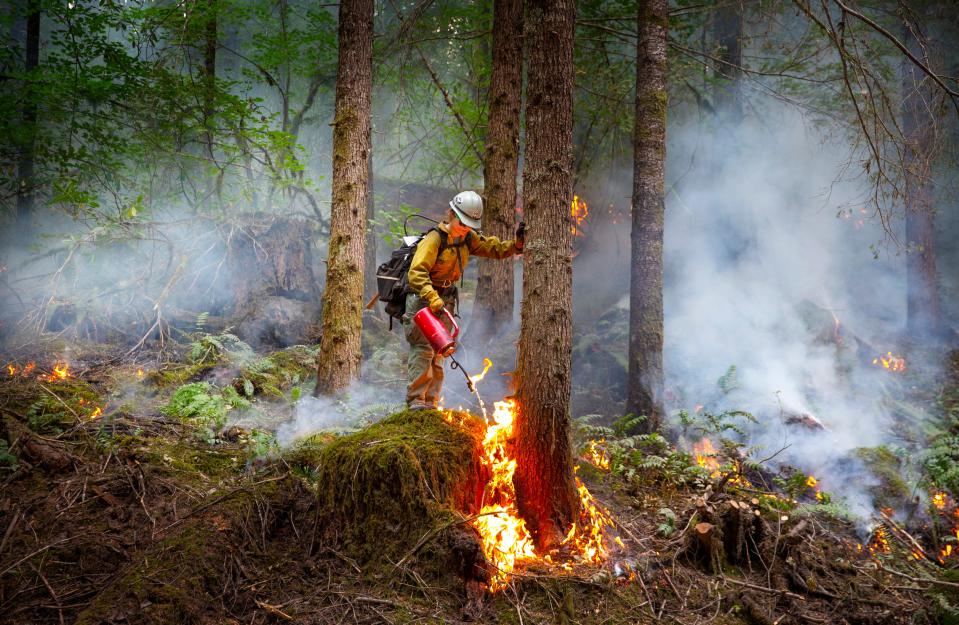Cedar Creek Fire grows by 17,000 acres, mostly due to burning operations
Cedar Creek Fire managers planned Saturday morning to burn more unburnt areas on the fire's perimeter, continuing a strategy begun after a dangerous east wind event ended last weekend and the weather began to get cooler and wetter.
The Cedar Creek Fire has been burning east of Oakridge since it was sparked by lightning at the beginning of August, but rapidly spread west between Sept. 9 and Sept. 10 when winds came in from the east. The greater Oakridge-Westfir area was threatened during that time, and residents were put under a Level 3 (Go Now) evacuation order Friday.
The threat decreased when winds died down, but High Prairie, Oakridge and Westfir areas remain at Level 1 (Be Ready).
The Cedar Creek Fire was 0% contained as of Saturday morning, but increased moisture over the coming days should allow firefighters to reach some level of containment on the northwest side of the fire to protect the Oakridge area, James Osborne with Pacific Northwest Interagency Incident Management Team 3, said during a virtual meeting Saturday.
Osborne said fire intensity in the 2021 Kwis Fire burn scar will be low, but future burning operations there are likely.
"Fire scars that are fresh generally help us out as a control feature," Osborne said. "Over the next coming days with the moisture, after that moisture kind of fades away, we will still be looking at continuing to burn that piece out to make sure that it's secure knowing that we've had one east wind event so far and there's the potential for more."

Increased humidity and rain in the coming days may decrease firefighters' ability to conduct burning operations.
More:Cedar Creek Fire threats to Oakridge area diminished but not gone
The Cedar Creek Fire was estimated to be 86,734 acres Monday morning, but reconnaissance flights later that day saw the estimate revised to 92,548 acres. Fire managers estimated the size of the wildfire Friday morning was 93,427 acres.
Throughout the week, fire managers found opportunities to start fires in areas untouched by the Cedar Creek Fire. By burning up ridges and other dense fuel sources, firefighters hoped to remove potential fuel for any future pushes by the fire.
On Thursday, fire managers reported clear weather on the west side of the fire, allowing for firing operations in multiple areas around the fire perimeter, including aerial ignition on ridges near Huckleberry Lookout and northeast of Kwiskwis Butte.
Firefighters also conducted burning operations to bring the fire along the containment line on Forest Road 2409.
The firing operations continued through Friday, and were reported Saturday to be responsible for most of the increase in the fire's estimated size. The fire was estimated at 110,361 acres Saturday, nearly 17,000 acres more than on Friday.
"We were lower on the temperature and higher on the humidity yesterday than we expect to see fire carried, but took the opportunity anyway to see what we could accomplish, and had a good day," Randy Johnson, Pacific Northwest Interagency Incident Management Team 3 incident commander, said in an update Saturday morning.
Johnson said firing operations on the western side of the fire would continue as weather allowed. He said reducing fuels there would help prevent the fire from being able to push toward Oakridge again in another wind event.
The use of extensive burning operations is raising some concerns, according to Ralph Bloemers, director of fire safe communities for Green Oregon, a group focused on documenting wildfires and their effects on Oregon communities.
“There is a big concern in the local community that bulldozers have been and are being used to cut fire lines into wild areas, cut down trees along scenic byways and that aerial ignition of new fires is torching rare, old growth forests. The fire lines they cut in mid-August proved futile when the dry east wind came in September" Bloemers said in a statement. "Even if much of the operations were carried out with due care, the larger question in my mind is whether the millions of dollars could have been better spent hardening homes and communities like Oakridge."
Contact reporter Adam Duvernay at aduvernay@registerguard.com. Follow on Twitter @DuvernayOR
This article originally appeared on Register-Guard: Cedar Creek Fire grows by 17K acres, mostly due to burning operations

